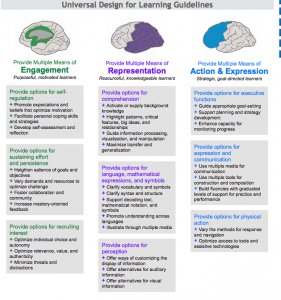6 Universal Design for Learning
UDL
This course development process has asked you to consider the needs of the three separate learners you created in your learner profile. At each stage, you reflected on those learners and altered your course plans based on their needs. The core principle behind these kinds of adaptations is to promote course design that allows diverse learners to succeed in your course. What we have learned over time is that alterations to your course that increase accessibility may be essential to some of your students, but are good for all students.
“Essential for some, good for all” is the central message of Universal Design for Learning (UDL). UDL is a set of guidelines that is shaped around three key principles:
- Multiple means of representation. Present the central concepts of the course using multiple media, such as text, speech, illustration, video or graphics.
- Multiple means of action and expression. Allow students to show what they know using a variety of formats, such as writing, audio, illustration, demonstration, video or drawing.
- Multiple means of engagement. Provide students with choice and autonomy within the course about how they engage with it.
Want a bit more information on UDL? Check out this short video.
Video: “UDL – Universal Design for Learning” by StratTrans can be found online at: https://www.youtube.com/watch?v=FSHflViWRCQ
Guidelines
Take a moment to review the UDL Guidelines.

Visit the National Center for Universal Design for Learning to read more about UDL and to access resources developed to help support the application of UDL guidelines: http://www.udlcenter.org
We also recommend this useful graphic organizer: Universal Design for Learning Guidelines

